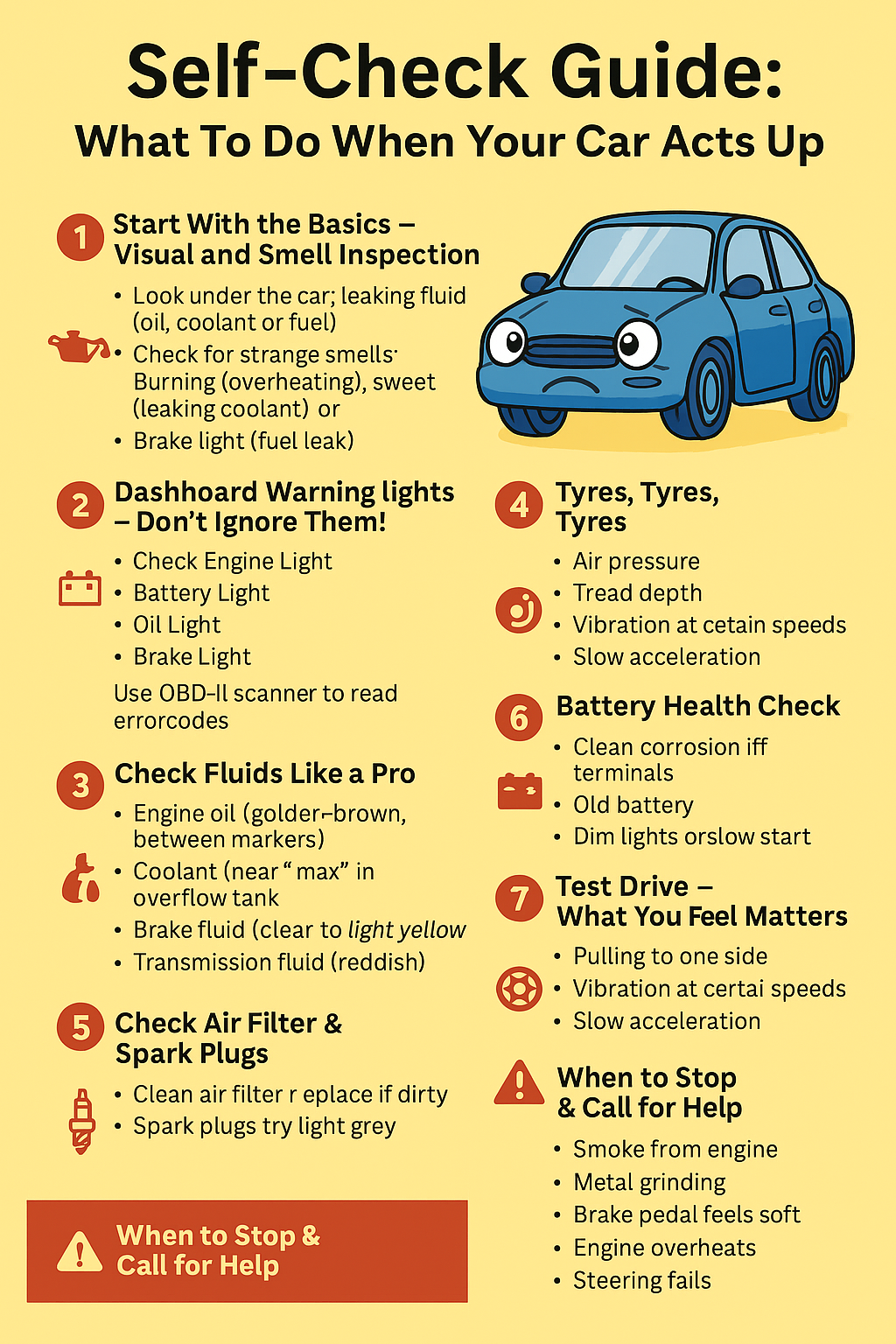Your car is like a friend—usually reliable, but sometimes… it acts up. Whether you’re hearing weird sounds, feeling odd vibrations, or seeing warning lights, it helps to know what you can check before rushing to a mechanic.
Here’s your go-to guide for self-checking your car when it starts giving you trouble.
🔥 1. Start With the Basics – Visual and Smell Inspection
- Look under the car: Any leaking fluid? (Oil = black/brown, coolant = green/yellow, transmission fluid = red/pink)
- Smell anything strange?
- Burning = overheating
- Sweet smell = leaking coolant
- Gasoline = fuel leak (dangerous!)
🧼 Pro Tip: Always check in daylight or with a flashlight on a flat surface.
⚠️ 2. Dashboard Warning Lights — Don’t Ignore Them!
If your car has turned into a disco party on the dashboard, here’s a quick meaning cheat sheet:
- Check Engine Light: Could be minor (like a loose gas cap) or serious.
- Battery Light: Alternator or battery trouble.
- Oil Light: Stop immediately—low oil pressure can destroy the engine.
- Brake Light: Check fluid level and brake response.
📱 Use an OBD-II scanner (cheap online) to read error codes instantly.
🔊 3. Listen Carefully — Sounds Tell Stories
- Clicking when turning? CV joints.
- Squealing when braking? Brake pads are worn.
- Grinding while starting? Starter motor or flywheel issues.
- Knocking while driving? Engine trouble or bad fuel.
🧠 Trust your ears. Weird sounds often mean something is wearing out or misaligned.
🌡️ 4. Check Fluids Like a Pro
Pop the hood and check:
- Engine oil: Dipstick should be between markers, golden-brown, not sludgy.
- Coolant: Should be near “max” in the overflow tank (only check when engine is cold!).
- Brake fluid: Should be clear to light yellow. Dark = needs changing.
- Transmission fluid (if accessible): Should be reddish and clean.
🛞 5. Tyres, Tyres, Tyres
- Air pressure: Check weekly. Low pressure = poor fuel economy and tyre wear.
- Tread depth: Use a coin or tread gauge. If it’s worn, replace.
- Vibration while driving? Could be tyre imbalance or alignment.
🔋 6. Battery Health Check
- Corrosion on terminals? Clean with baking soda and a toothbrush.
- Old battery (3+ years)? Get it tested.
- Dim lights or slow start? Might be dying.
🕹️ 7. Test Drive — What You Feel Matters
Take a short, quiet drive and pay attention to:
- Pulling to one side? Alignment issue.
- Vibration at certain speeds? Tyre balancing or suspension issue.
- Slow acceleration? Could be air filter, spark plugs, or fuel system.
🧰 8. Check Air Filter & Spark Plugs (If You’re Handy)
- Air filters are often under a plastic housing — clean or replace if dirty.
- Spark plugs should be dry and light grey. If black or wet = trouble.
🚨 When to Stop & Call for Help
Stop driving immediately if:
- Smoke is coming from the engine
- You hear metal grinding
- Brake pedal feels soft
- Engine overheats
- Steering fails
✅ Final Thoughts: Know Your Car, Save Your Wallet
Learning to self-check your car doesn’t make you a mechanic, but it can help you:
- Spot small issues before they become disasters
- Avoid being overcharged
- Stay safe on the road
- Gain confidence in handling minor car issues
“A well-treated car will whisper before it screams.”
Do you want a downloadable checklist PDF, infographic, or video script version of this blog? I’d be happy to prepare it!

